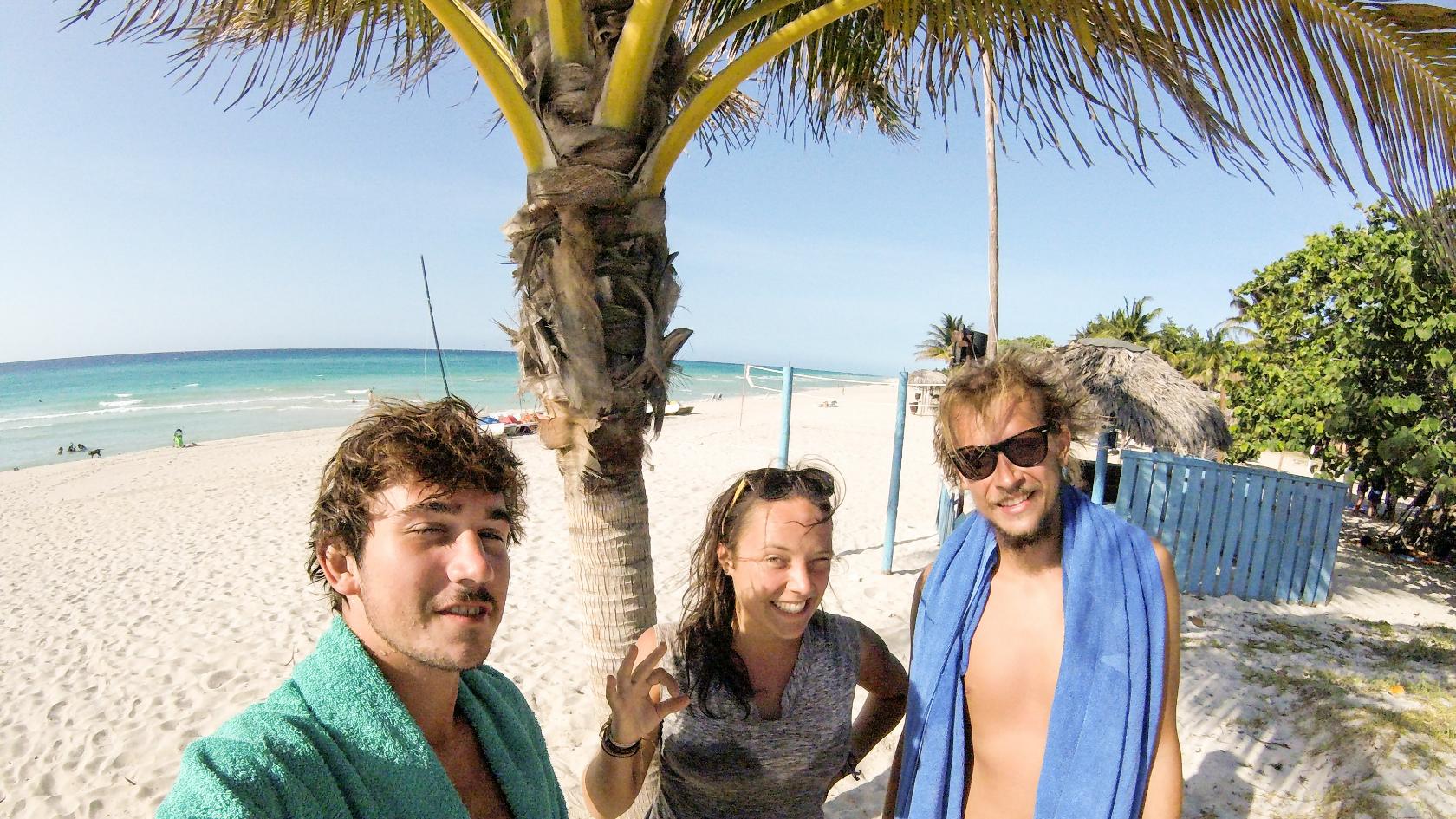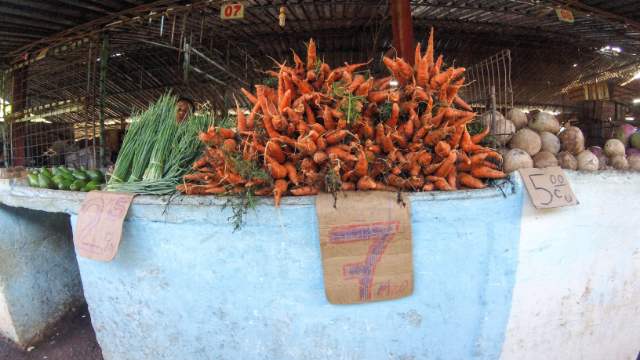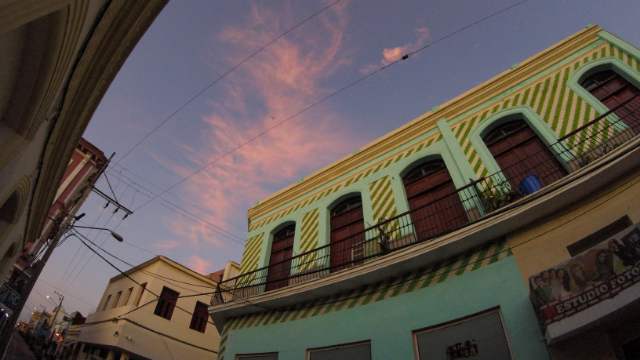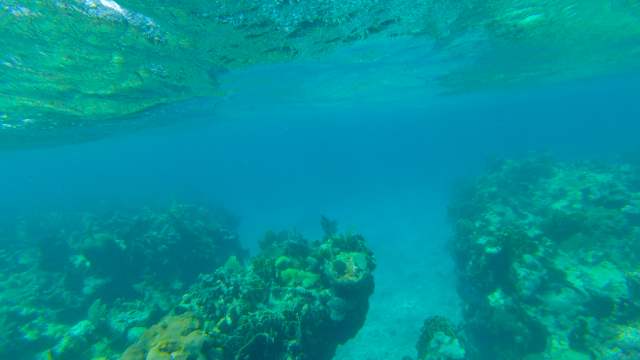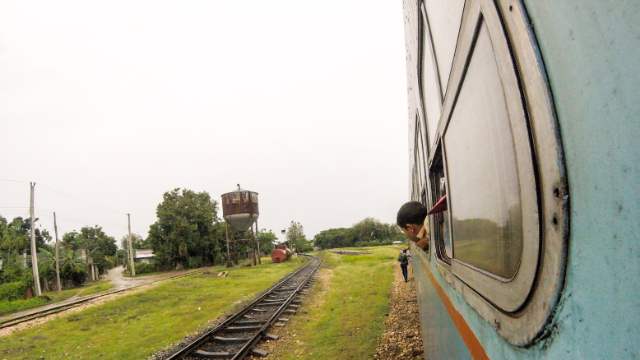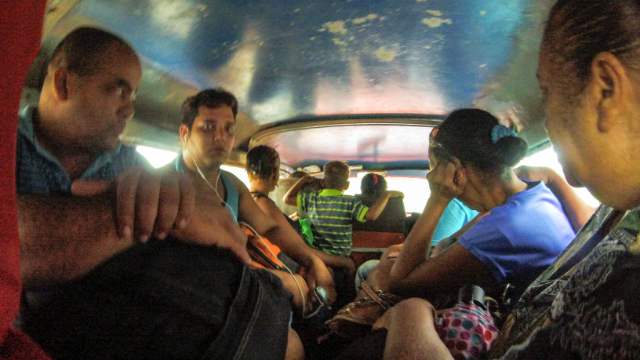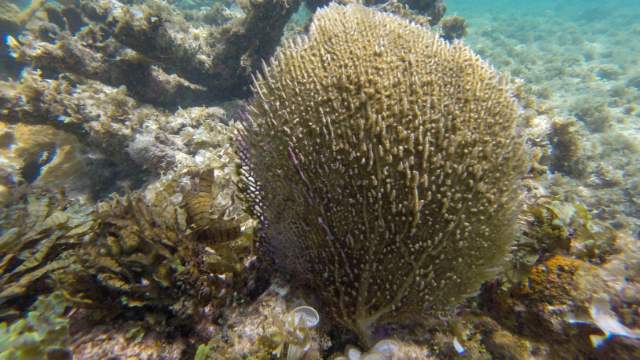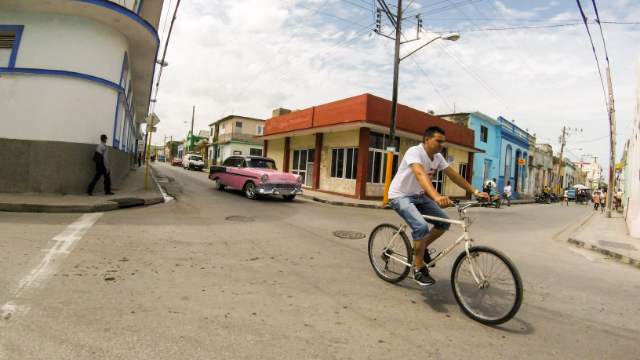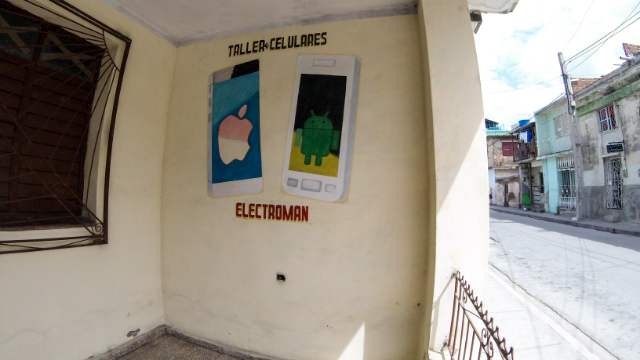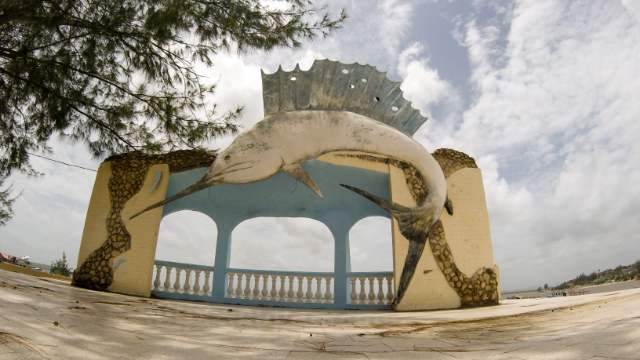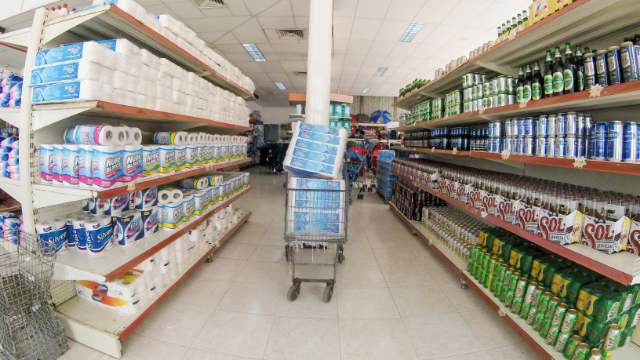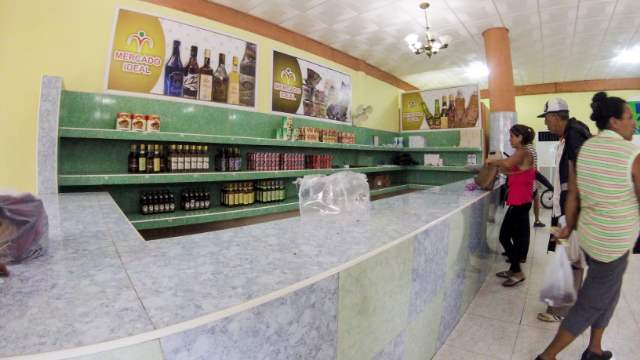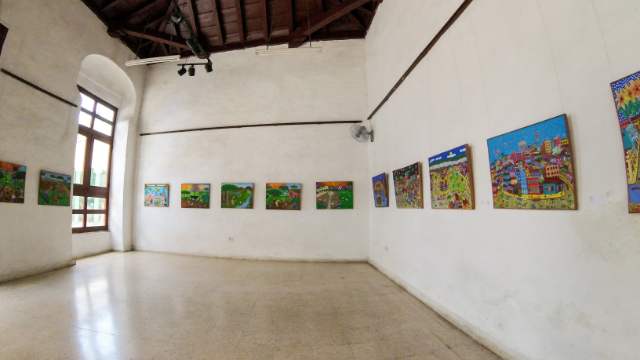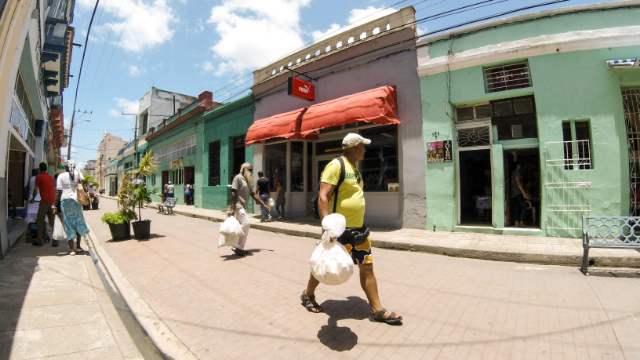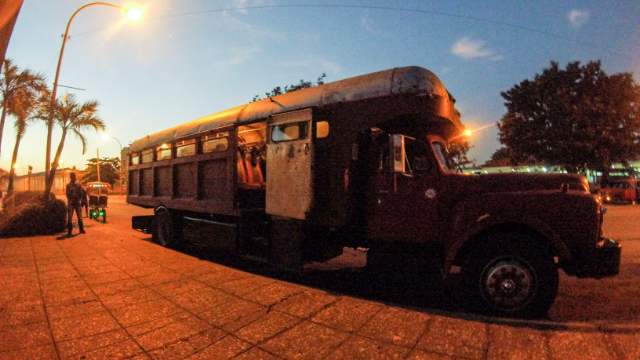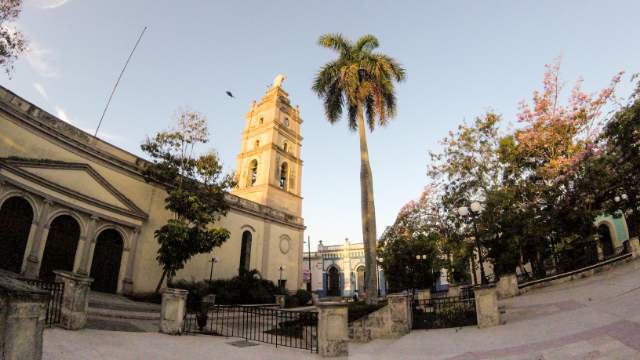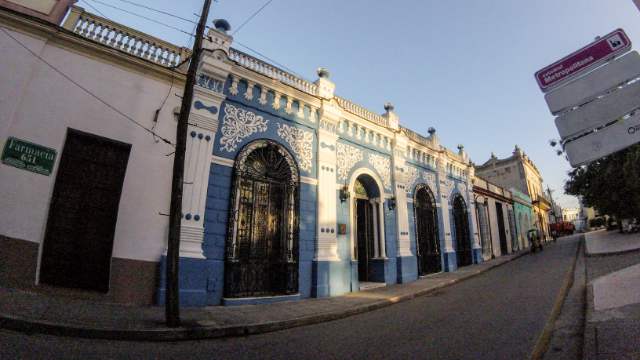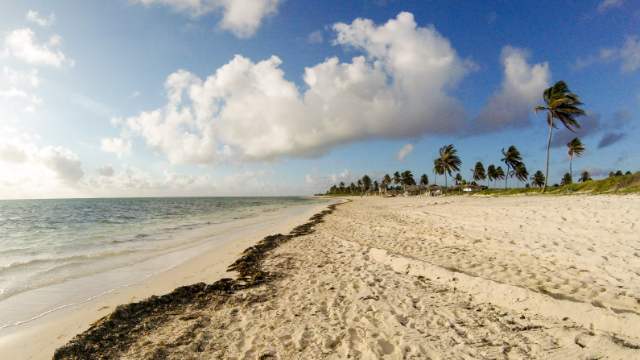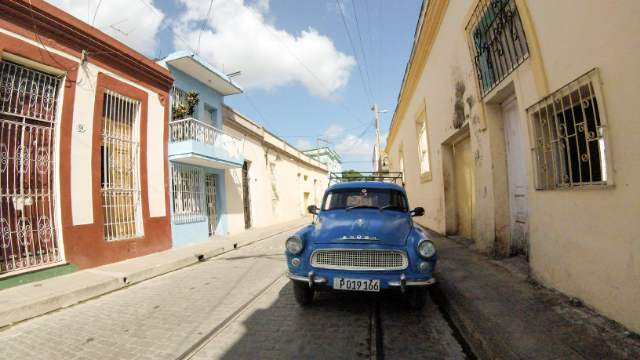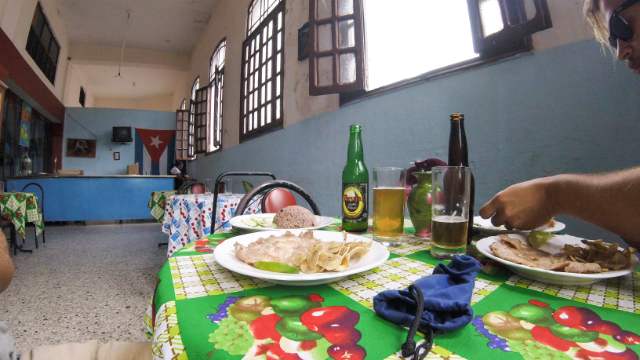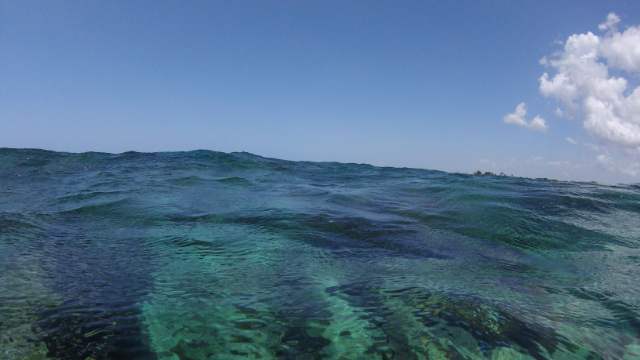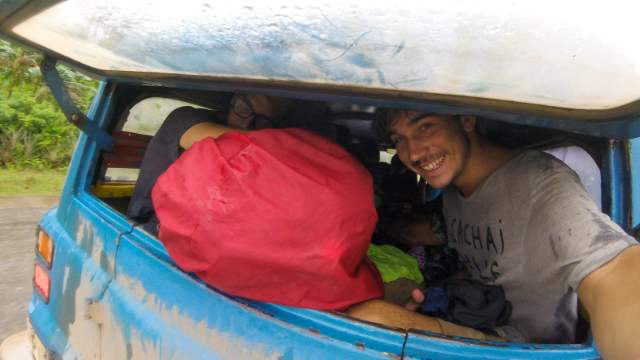Before you go
Take with you a small 30L backpack, 2-3 t-shirts, a shirt, shorts, swimsuit, 2 pairs of underwear and socks, flip flops, sunglasses, sunscream, snorkeling mask, a book and camera. You don’t really need proper hiking shoes, take something comfortable.
Flying in is good from Mexico ($100 with Interjet) or Germany if you come from Europe (€250 flight with Eurowings). You need a tourist card, which costs apx. $10 when flying in from Mexico and you can ask for it when checking in your luggage. Flying out is possible to the USA or Canada as well among the above options.
It’s advisable to buy a water filter, it costs $25, which is what you’d end up paying for bottled water anyway.
Find all information you need beforehand. There’s internet in Cuba, but it’s expensive. Although you get ‘unlimited’ bandwidth, 1hr of surfing costs $1,5. You can connect to wifi with internet in public places like some squares, parks or whenever you see a lot of locals on their smartphones.

Get offline maps like Osmand or Maps.ME. This helps a lot when navigating around the city because you cannot expect the locals to help you, they’ll tell you to take a taxi.
It’s not necessary to take too much cash inside Cuba. There are widely available ATMs charging 3% commission on withdrawal of whichever amount (better than Argentina’s 5%). The currency exchange offices charge about 1-2%.
Understand the convertible currency is CUC and it’s apx equal to US dollar. It’s called peso convertible and all bills will have this inscribed on them. You’ll need CUCs for accommodation, fancy restaurant and transport (taxis or sometimes camionetas). Then there is the peso nacional (CUP) and 1 CUC is worth 25 CUPs. You can buy everything you’ll need (transport, food, beer, rum) in Cuba in CUPs but accommodation. You can get CUPs at the exchange office (cadeca) without any problems (except for the airport one!). We exchanged more than half of our money in CUPs.
Before you go, beware that Cubans are friendly because they want your money. It’s a sad reality, but not all of them are like that. If you ask them about a good local restaurant, they’ll send you to the most expensive restaurant around because they get commission. Same with accomodations. They are not gonna help you if they see no profit from you and if so, they’d be reluctant (our experience).
Decide which type of vacation you want. If you’re in Cuba to relax, it’s best for someone to arrange your holiday. If you want to truly explore the country, it’s opposite to vacation but very rewarding experience-wise.
Finally, it’s better to go to Cuba with someone to split costs. Accommodation will be cheaper (price per room) and overall you have greater negotiating power in 2 people. I split this guide in transportation section, accommodation, food and drinks and finally ending with some tips on what to do.
Transport:
This is the hardest part. Gas is expensive and there are few buses or camionetas so everything is working against you. Moreover, locals give foreigners way higher prices (from 2x to 25x the official price) and you have to do hard bargaining if you don’t wanna be ripped off.
As a tourist, you can officially use Viazul or taxis and you pay them in dollars (cucs) - here you pay up to 25x more than locals. You still need to book Viazul in advance and queue up etc. You cannot use omnibus nacionales or omnibus de trabajadores.

If you’re on a budget and don’t mind low comfort, you can queue up for camionetas (animal carriage trucks converted into buses) and this option works out at around 30 CUP ($1,20) per 100km. Expect crazy queues, hard prices negotiations, lower comfort (almost no legroom in some) and absurd wait times. Camionetas start going early around 6am and then maybe again early in the afternoon so to higher up your chances, do arrive early.

Another option is taxis collectivos which is uncomfortable and rather expensive at apx 3x the price of the camioneta for locals ($3-4 per 100km). Beware you need to negotiate to get this price.
There are also interprovincial buses called wawas, you can board them and they cost nothing but only provide service inside the province - we took a wawa on a 100km stretch from Camagüey to Santa Lucia for 5 CUP ($0,20!!). The downside is there’s only a few of them (1 max 2 a day) and generally very very early in the morning (5-6am).
Last and surprisingly quite comfortable option is to hitchhike. This is generally only advisable on the main highway number 1 to La Habana as there’s still little traffic in Cuba. The truck drivers will ask you for money so to get a ride, you need to stuck out your thumb and wave money at them in the other hand. For a truck ride from Santa Clara (gas station on km259) to La Habana we paid $3 for 260km. With money in your hand, the wait times are much less than for a camioneta (30min for us). I must say another truck previously took us 5km into Santa Clara for FREE but he said this doesn’t happen very often.
Inside cities, it’s best to use either intermunicipal buses (for 1CUP), horse taxis collectivos for 3-5CUP. Sometimes they’ll take you quite far for this fare like the bus from Havana to Playa del Este (30km). I would not advise using taxis collectivos or bici taxis as the prices tourists get are in dollars (CUC) and it’s very likely you can get ripped off. And most of the times, you can walk almost everywhere in the city.

Oh, I almost forgot the train. Slow, difficult and unreliable service. You need to buy in advance, then queue up to spend not so great 22hrs on the train. It’s not so bad, just bear in mind the seats are uncomfortable, the air smells toilet and it is hot inside. On the other hand, there is enough legroom and you get to Santiago de Cuba or Guantanamo for around 30 CUC. The ticket office opens from Monday to Friday from 8am to 4pm (by 8am Monday it was crowded) and sometimes on Saturday until 11am. The trains leave every 4 days, but since the train to Guantanamo leaves the day after the Santiago one, there are roughly 4 weekly trains going east. It’s an interesting experience for sure.
Accommodation
Foreigners can use casas particulares marked by a blue symbol with ‘aprendador divisa’ sometimes written underneath, meaning they charge in dollars (CUC). If you’re in Cuba off-season, you can cut the price considerably from the high-season standard charge of 20-25 CUCs per room. It’s good to know they will likely have no one else otherwise and will accept almost anything down to $10 per room ($15 for sure). This means you can divide the nightly rate by two or three, depending on how many people are in your group and the size of the room. Although accommodation is a large part of the budget, it is cheap in Cuba. Also, in bigger cities, there are easily more than 100 casas, don’t be afraid to walk off if you feel like the price is too high.

We never had food in the casas particulares as they charge about $3 for breakfast and for this price, you can find 2-3 full meals in restaurants priced in CUP (easily 30-35 CUP for a meal). Also avoid getting drinks from the fridge and ask them whether they can give you filtered water.
We didn’t stay in hotels nor did we camp although it’s possible to. But it’s really hot in Cuba and the casas are usually really nice with a terrace as well, why not enjoy yourself?
Food and drinks
You can buy all your food for CUP or national money. There’s no need to cook for yourself.

You can eat out at restaurants or comedores very cheap. Look for places where locals are and even better for a daily offer board with prices. You can eat from 15 CUP a meal with black bean rice and smaller bistec, for 30-35 CUP ($1,20) on average for a generous completo up to 60 CUP ($2,50). Up to 100 CUP ($4) for seafood. You shouldn’t be paying much more.

You can buy sandwiches from 3 CUP ($0,05) to 10CUP ($0,20), on average expect 5 CUP ($0,10). They also do “pizza” on a thick bread for 5-10 CUP depending on the ingredients. All snacks should cost around 5 CUP.
What is very expensive is water $0,7 per 1,5L bottle. But here, you can again buy refrescos (soft drinks) for 1CUP or jugo natural (mango, guayaba, papaya) for 2-3 CUP for 220ml. Refresco enlatado (canned soda) costs $0,5.
If you fancy beer, you can get imported cerveza presidente (Guatemala) or Heineken for one dollar a small can 330ml. There is Cuba made beer as well, Cristal or Bucanero - it’s alright and costs the same. We later discovered much cheaper beer - it’s called cerveza dispensada and costs 6-10 CUP for a 330ml cup ($0,10-0,20). It’s not so good but this is the beer Cubans drink. All Cuban beer is not properly made - they add sugar to it. The cheapest option is going to the market where you can get dispensado for 3 CUP not sure for how much but locals get gallons of it.

Rum costs around 60-100 CUP ($2,5-4) for a 700ml bottle. Rum dispensado is sold for 15 CUP for the same amount or 1,2 CUP a shot ($0,05). It’s not the best rum I had but it’s pretty good.

Cigars and cigarettes. One cigar costs 1 CUP ($0,05) at local markets and are called ‘tabacos’. You need to go around to find them, they don’t have them everywhere, but once you do find the right shop, you find true Cuban cigars and they are pretty good as well. Another option is to buy Montecristo or Cohiba cigars for $1-2 dollars from pimps in the street (in front of official tobacco dealership). Cheapest cigarettes ($0,3) per package of 20 and are called populares. They are made of leftover tobacco for cigars and are strong.

Other perks include very good ice cream coopelita for 2-5 CUP ($0,10). Condoms for 1 CUP. Entire cake for 15CUP ($0,30). Cheap fruits - Mango for 5CUP, Ananas for 10 CUP, Banana for 1CUP each etc..
What to do in Cuba
Skip the nature and explore socialism. Cuba is mostly a flatland, it’s not as interesting to see if you’ve already been to other places in South America, Europe or North America… There are some mountains in eastern Cuba, but really not that special.
Focus on beaches/snorkeling/diving and socialism - try to see for how long you can bear it. Use the system to live cheap and to explore the many faces/layers of Cuba. There are huge social inequalities in a country proclaiming humanly equality. It’s a system full of absurdism - people wasting time by having to wait for everything: bus, queues for food rations, for government paperwork… It’s an utopian dream that failed, everything is about to collapse yet it somewhat works. For some. There’s not enough public transport, water infrastructure is leaking so they switch water on only once a day for 2hrs so that the cities are not flooded. Cubans either love it (mostly those making dollars and living on national peso) or hate it (they see how behind is the country and how little their salaries are 300-800 CUP per month!!). Everyone has to do something aside their official job to survive and it’s unfortunately easiest to rip off a few tourists. Others are honest and make money by selling sandwiches, cooking or running ‘home shops’ in their free time. Try to live in this system for 2 weeks and see if you can make it (we stayed for 3 weeks and were so fed up with everything we wanted to leave after the first week). It’s really shocking but definitely good to see. When you’re fed up, head to the beach.

If you have time, go to Eastern Cuba as there are fewer tourists. That doesn’t mean locals will not try to scam you. I would recommend seeing Camaguey (stay 3 days, eat good food and visit art galleries for free),. From there, take a day trip to Santa Lucia beach with the wawa for 5CUP (or stay longer). Pay a visit to Santa Clara (1-2 days for crazy ice cream place, cerveza dispensada, nice food, rum decano and decent bars). Then head over to Cienfuegos with a camioneta for 20 CUP (intermunicipal terminal), it’s a nice seaside town with locals. Spend some days exploring La Habana (not Habana Vieja!). Take a city bus to Playa del Este for 1 CUP, it’s a beautiful white sand beach with azure water 30min away (don’t go during the weekend, it’s trashed and too crowded!).

Finally, it’s always nice to relax so plan a few days in Varadero. You can live for cheap in Santa Marta, from where it’s 15min walk to the beach. There are excellent places for eating out as well, several supermarkets and ice cream shops. This is the best Varadero for backpackers.

On the way in or out of Varadero, stop at Playa Coral for some excellent coral snorkeling for free. Matanzas are also worth a stop, it’s full of hidden gems such as 37 kinds of coffee cafe! Varadero to Habana is an easy bus (wawa) or camioneta ride, about 3hrs in total and 50 CUP.
Now it’s up to you to pack up and hit Cuba as part of your next adventure. Enjoy!
